Fisher Body Number Plate - 1965
[ Preface ] | [ 1964 ] | [ 1965 ] | [ 1966 ] | [ 1967 ] | [ 1968 ] | [ 1969 ] | [ 1970 ] | [ 1971 ] | [ 1972 ]
[ Atlanta ] | [ Baltimore ] | [ Euclid ] | [ Framingham ] | [ Fremont ] | [ Kansas City ] | [ Oshawa ]
Introduction: For quite some time I’ve had an intense interest in Fisher Body Number plates, a.k.a. trim tag, cowl tag, firewall tag, etc. for 1964 through 1972 Chevelles - hereafter referred to as ‘trim tag’ since that seems to be most common moniker for these little jewels. Their diversity, not only between the different years but between the different plants in a given year, has always fascinated me. This page deals only with 1965 Chevelle trim tags.
The second model year of the Chevelle, 1965, saw its final assembly production occur at 5 plants in the U.S. - Atlanta, Georgia - Baltimore, Maryland - Fremont, California - Framingham, Massachusetts - and Kansas City, Missouri - plus Oshawa, Ontario in Canada. It’s also interesting to note that Fisher Body had a Fisher Body plant in Euclid, Ohio and this plant supplied bodies to at least Baltimore, Atlanta and Kansas City in 1965, most notably the 300 series 2-door station wagon (13215) and El Caminos (134/13680) to Baltimore, Kansas City, and even Atlanta. This is the only known year that the El Camino series was assembled at the Atlanta final assembly plant. Whether this was a GM decision, a union negotiation, or simply that Atlanta, Baltimore, and Kansas City were not geared up to meet the expected demands of these particular body styles is not known. It's been postulated that Atlanta felt left out of the El Camino market so GM decided to let Atlanta assemble them for the 1965 model year but since Euclid stopped supplying bodies to final assembly plants after 1965, and Atlanta was not tooled to do it in-house, El Caminos were not assembled at Atlanta after the 1965 model year.
I’ll not attempt to decode what each trim code, paint code, and where applicable, group option codes in this series represent. Click on any year's link in the navigation menu at the top of the page and choose the appropriate link on that year's home page where you’ll find links for detailed information for interior, paint, and group option codes.
All research to date indicates that each Fisher Body plant assigned body numbers in sequential order based on the particular Fisher Body style number. This means that a 2-door sedan built immediately after a Malibu SS convertible would not have sequential body numbers, or even close, since they are different styles. Depending on production numbers of a particular body style number throughout the model year, the above 2-door sedan and Malibu SS convertible would be vastly different on a given day of assembly but the next 2-door sedan or Malibu SS convertible would have a sequential body number for that particular style.
The Fisher Body unit number has nothing to do with the vehicle identification number (VIN) assigned by GM at final assembly and if any were to match, it’d be a coincidence.
The 1965 model year is the first year that the series designation for Chevelle 300, 300 Deluxe, Malibu, and Malibu SS begins with 13xxx and the VIN begins with the GM division (1 for Chevrolet). Fisher Body style numbers are all 5-characters long. This Fisher Body style number designation on trim tags would continue through 1972.
With that, let's begin 1965.
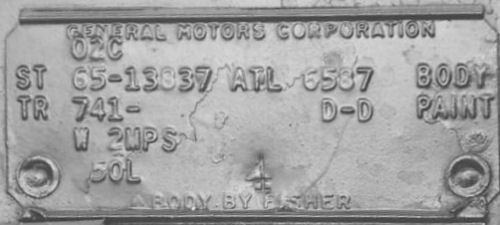
The 1965 Atlanta trim tag has 5 lines of information. In addition,
a base (blank) trim tag has the verbiage:
GENERAL MOTORS CORPORATION
and
BODY BY FISHER
The first information line has the body assembly date consisting of the month as a 2-digit number and a single letter (A…E) designating the week. When the month is a single digit month (January through September) the month number is padded with a leading zero (0) such as 01, 02, 03, etc. This body date is embossed below the GENERAL MOTORS CORPORATION stamping. In the example 02C is the 2th month (February) and “C” represents the 3rd week.
The second information line contains the abbreviation ST (for Style) followed by the model year (65), a hyphen and the Fisher Body style number. Next is the designation for the plant location, ATL for Atlanta, and the Fisher Body unit number followed by BODY. It should be noted that the Fisher Body style number (13837 for a Malibu SS sport coupe in the example) has nothing to do with the GM VIN series/model designation. That means the 13837 does not indicate a V8 engine just because the third digit is an even number. Fisher Body did not care if the car was to receive a V8 or L6 engine. Generally, the Fisher Body unit number, 6587 in this case, was sequential for the particular Style number.
The third information line contains the abbreviation TR (for Trim) followed by a 3-digit number and a hyphen indicating the seat type and color; the reason for the hyphen is not known at this time. Next is a 2-character sequence indicating the exterior paint color with the lower body color represented by the first letter, a hyphen, and the upper body color represented by the second letter, and finally the word PAINT.
The fourth information line contains various letters and numbers indicating the various option groups (1 through 5) with a number and letters for various options the car was ordered with within those groups. It should be noted that the first group of options does not have the number “1,” the letter “W” is in the first option group in this example. The first 3 groups are embossed on the 4th line while the 4th and 5th groups are found on the 5th line if applicable.
In the example shown, there is also a hand stamped number (4 in this example) that is believed to be a final inspector’s stamp. This 1- or 2-character hand stamped number has been found in various locations on the trim tag so it won’t always be in the same location as the example.

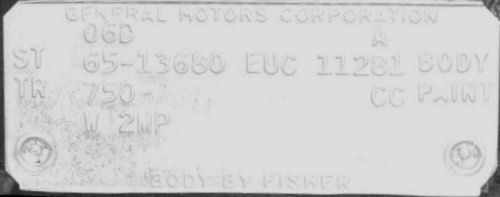
The Euclid, Ohio Fisher Body plant also supplied El Camino bodies to the Atlanta final assembly plant; the only known year the El Camino body style was assembled in its final form at Atlanta. Note the differences in the Euclid trim tag; the "A" in the upper right corner designated Atlanta as the final assembly plant, "EUC" identifies the Fisher Body plant at Euclid, trim code has a -B after the code to indicate a bucket seat color but did not use a -A when a bench seat was involved.
More on the Euclid plant later.

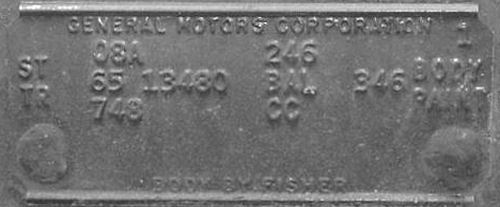
The first information line has the body assembly date consisting of the month as a 2-digit number and a single letter (A…E) designating the week. When the month is a single digit month (January through September) the month number is padded with a leading zero (0) such as 01, 02, 03, etc. Next is a 3-digit number that corresponds to the Job Number found on trim sheet for that car. Lastly, the first line (although found in other locations throughout the model year, most notably the bottom right corner as well) is a single number. It’s believed this number is for the body jig, or gate, the body was assembled on and used for quality control.
The second information line contains the abbreviation ST (for Style), followed by the model year (65) and style number. Next is the designation for the plant location, BAL for Baltimore, and the Fisher Body unit number followed by BODY. It should be noted that the Fisher Body style number (13667 for a Malibu convertible or 13480 for a 300 Deluxe sedan pickup in the examples) has nothing to do with the GM VIN series/model designation. That means the 13667 or 13480 does not indicate a V8 engine just because the third digit is an even number. Fisher Body did not care if the car was to receive a V8 or L6 engine. Generally, the Fisher Body unit number, 1260 and 346 in these examples, was sequential for the particular STYLE number.
The third information line contains the abbreviation TR (for Trim) followed by a 3-digit number indicating the seat type and color. Next is a 2-character sequence indicating the exterior paint color with the lower body color represented by the first letter and the upper body color represented by the second letter, and finally the word PAINT. If the car has a vinyl or convertible top, the second character in the paint code is a number and designates the top's color.
The fourth information line the single number as explained in the first information line paragraph above if this number is not present on the first line.
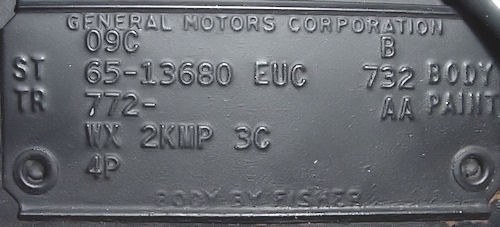
Baltimore-assembled El Camino bodies were also supplied by the Euclid, Ohio Fisher Body plant. There are some differences in the trim tags from Euclid. Of note are the hyphen character between the model year (65) and the Fisher Body style 13680. The designation EUC is shown the style number to designate Euclid and the letter “B” on the first line is to designate this body was destined for the Baltimore final assembly plant. As was the practice at Euclid, information lines 4 and 5 showed group option codes that Baltimore itself did not include. More on the Euclid, Ohio plant later.
The Euclid, Ohio Fisher Body plant built various body styles for final assembly at Atlanta, Baltimore, and Kansas City. Most notably were the 2-door station wagon but El Caminos were also built in Euclid for Atlanta, Baltimore, and Kansas City final assembly.
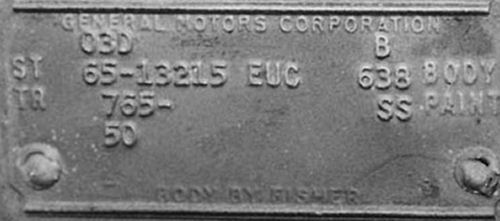
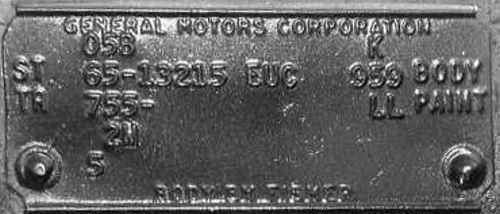
Typical Euclid, Ohio trim tags for a 2-door station wagon destined for the Baltimore and Kansas City final assembly plants as noted by the letters "B" and "K" in the upper right hand corner.
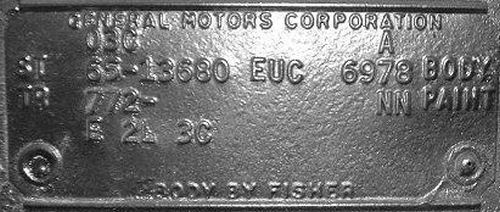
Typical Euclid, Ohio trim tag for a Malibu sedan pickup (El Camino) destined for the Atlanta final assembly plant as noted by the letter "A" in the upper right hand corner. Euclid also built El Camino bodies for Baltimore and Kansas City.
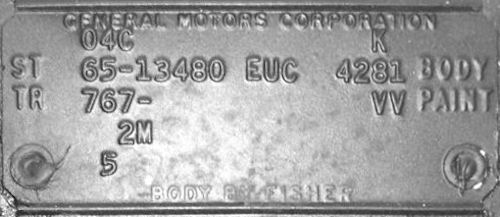

Confirmed for at least the Kansas City final assembly plant, Euclid would indicate the style number with an even 3rd digit even though the final Chevelle (pickup in this case) was an L6 pickup.
First year for the Framingham plant to assemble Chevelles and Framingham would continue to do so through the 1969 model year.
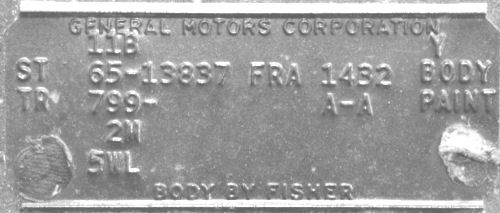
The first information line has the body assembly date consisting of the month as a 2-digit number and a single letter (A…E) designating the week. When the month is a single digit month (January through September) the month number is padded with a leading zero (0) such as 01, 02, 03, etc. The right corner is a single letter designating the interior trim paint color.
The second information line contains the abbreviation ST (for Style), followed by the model year (65), a hyphen, and style number. Next is the designation for the plant location, FRA for Framingham, and the Fisher Body unit number followed by BODY. It should be noted that the Fisher Body style number (13837 for a Malibu SS sport coupe in the above example) has nothing to do with the GM VIN series/model designation. That means the 13837 does not indicate a V8 engine just because the third digit is an even number. Fisher Body did not care if the car was to receive a V8 or L6 engine. Generally, the Fisher Body unit number, 1432 in this example, was sequential for the particular STYLE number.
The third information line contains the abbreviation TR (for Trim) followed by a 3-digit number indicating the seat type and color and followed by a hyphen character. Next is a 2-character sequence indicating the exterior paint color with the lower body color represented by the first letter, a hyphen, and the upper body color represented by the second letter, and finally the word PAINT. I have no examples of convertibles or known vinyl top Chevelles from Framingham for 1965 so it's not known, by me at least at this time, if the upper body color code is shown as a number for the convertible/vinyl top color.
The fourth (and fifth if applicable) information line contains group option codes.
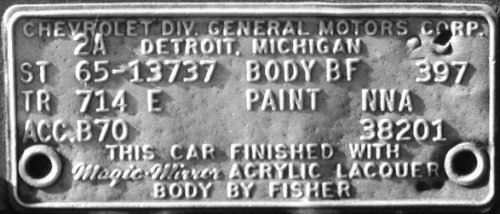
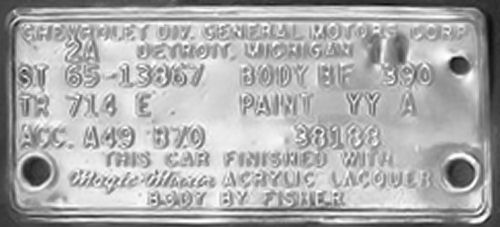
Fremont continued to use the same trim tag design and verbiage from the 1964 model year when all other plants changed to a more 'standardized' design.
The first information line has the body assembly date consisting of the month as a 1- or 2-digit number and a single letter (A…E) designating the week. When the month is a single digit month (January through September) the month number is not padded with a leading zero (0) but simply shown as 1, 2, 3, etc. This body date is embossed to the left of the DETROIT, MICHIGAN stamping. In the examples 12A is the 12th month (December) and “A” represents the 1st week and 3E is the 3rd month (March) and “E” represents the 5th week.
The second information line contains the abbreviation ST (for Style) followed by the model year (65), a hyphen and the Fisher Body style number. Next is the designation for the plant location, BF for Fremont, the word BODY, and the Fisher Body unit number.
Fremont is the only U.S. plant to match the Fisher Body Style number to the GM series/model designation in the VIN, meaning Fremont would use a style number such as 13737 to designate an L6 engine in the car where other plants would use a style number of 13837.
The third information line contains the abbreviation TR (for Trim) followed by a 3-digit number indicating the seat type and color. Next is a single letter to designate the interior paint color. This interior paint code letter has been found contiguous with the trim code such as 742B as well as separated by a space such as 714 E. Next is the word PAINT, then a 3-letter sequence indicating the exterior paint color. Unlike the other 1965 final assembly plants, Fremont used a 3-letter code for the exterior body paint as opposed to a 3- or 4-character number. The three letters indicate the lower body color, upper body color, and steel wheel paint color. Variations have also been found where some 3-character paint codes are contiguous such as NNA and some have a space between the body colors and wheel color such as YY A.
For some unknown reason, the paint code third letter for the wheel color is missing from most trim tags after 6A; of 10 trim tags I have from 6A through 7B, only two have a wheel color code, both happen to be 06D Malibu SS.
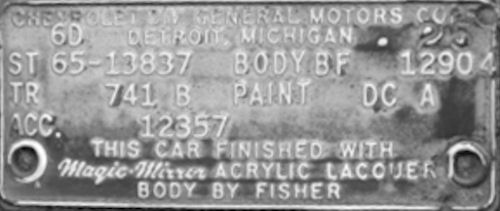
No convertible found to date has the top color designated with a number in the upper paint position and all convertibles to date are coded as a single color such as RR.

The same holds true for a Chevelle with a vinyl top, the upper paint color is shown as a letter and matches the lower body paint color letter. One known vinyl top trim tag does show the RPO code C08 on the fourth information line.
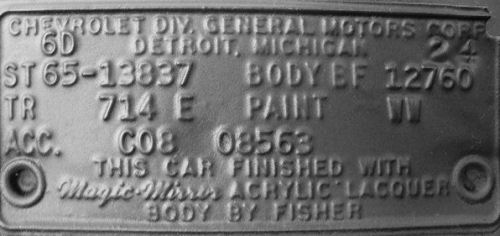
The fourth information line contains the abbreviation ACC. (for accessory) with various letters and numbers indicating the various accessories. To date only three have been found here; C08 vinyl top, A49 Front seat belt (with retractor) and B70 Padded Instrument Pad.
On the right side of the fourth line is a 2- to 5-digit number corresponding to the manifest sequence number from production broadcast notice and this number on the trim tag may be truncated from the original number on the manifest. This manifest number has also been embossed on the far left as well as the center of this line so positioning is not consistent.
Hand stamped on the trim tag is often found a 1- or 2-digit number that is believed to be a final inspectors stamping. Whether this was done on the Fisher Body side of the house or the final assembly line is not known at this time. Typically this hand stamped number is found in the upper right corner.
Kansas City final assembly plant trim tags were fairly straightforward with 4 lines of information and consistent throughout the model year and are very similar to the Framingham trim tags.
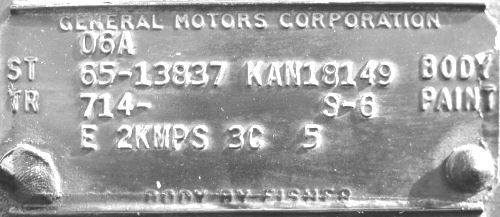
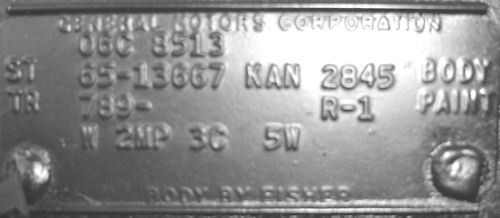
The first information line has the body assembly date consisting of the month as a 2-digit number and a single letter (A…E) designating the week. When the month is a single digit month (January through September) the month number is padded with a leading zero (0) such as 01, 02, 03, etc. Sometime between 06A and 06C, Kansas City added a 2 to 4-digit internal plant job number after the body date.
The second information line contains the abbreviation ST (for Style), followed by the model year (65), a hyphen, and style number. Next is the designation for the plant location, KAN for Kansas City, and the Fisher Body unit number followed by BODY. It should be noted that the Fisher Body style number (13837 for a Malibu SS sport coupe and 13667 for a Malibu convertibles in the above examples) have nothing to do with the GM VIN series/model designation. That means the 13837 does not indicate a V8 engine just because the third digit is an even number. Fisher Body did not care if the car was to receive a V8 or L6 engine. Generally, the Fisher Body unit number, 18149 in the Malibu SS sport coupe example, was sequential for the particular STYLE number.
The third information line contains the abbreviation TR (for Trim) followed by a 3-digit number indicating the seat type and color and followed by a hyphen character. Next is a 2-character sequence indicating the exterior paint color with the lower body color represented by the first letter, a hyphen, and the upper body color represented by the second letter, and finally the word PAINT. In the two examples above, the 13837 Malibu SS sport coupe has a vinyl top as indicated by the number "6" and the Malibu convertible has a white convertible top as indicated by the number "1."
On at least one example of a Euclid-built El Camino for Kansas
City, the -B appears after the trim code indicating a bucket seat
car. Typically the Kansas City plant does NOT use -A or -B for
bench/bucket designation but it's possible in this case since
the trim code (726) is ONLY for a red bucket seat El Camino.
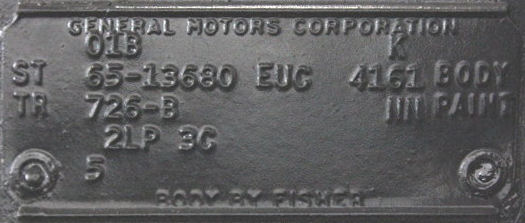
The fourth (and fifth if applicable) information line contains group option codes. The lone "5" in the first trim tag is often found with no option letters following it.
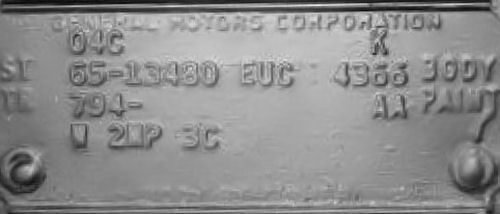
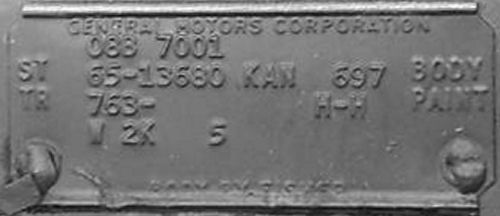
At least late in the model year Kansas City built its own El Camino bodies in-house as shown with the 08B dated trim tag. Sometime between 01A and 08B, Kansas City apparently farmed out the El Camino body style to the Fisher Body plant at Euclid.
Note some of the differences between the Kansas City trim tag and the one from Euclid. The Kansas City tag has the same 4-character tracking number that is found on other Kansas City body style trim tags late in the model year. The Euclid trim tag designates this final assembly plant as Kansas City with the letter "K" in the upper right corner just as it does with "A" for Atlanta and "B" for Baltimore.
The Oshawa, Ontario plant Style number does indicate whether the car was to have an L6 or V8 engine.
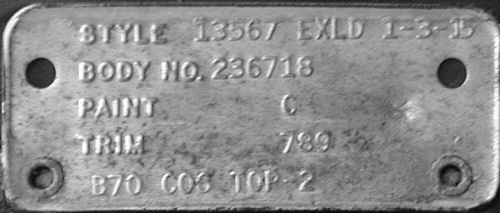

Chevelles built in Canada have trim tags vastly different from their U.S. counterpart and have 5 lines of information.
The first information line has the word STYLE followed by the particular body style designation, 13567 on the first example and 13867 on the second. The XLD on the first example also indicates the car was destined for export outside of Canada or U.S. - this one happened to be destined for Antwerp, Belgium.
Next is the assembly date; 1 is for the first shift (of 2 at the plant), a hyphen, followed by a number for the month, a hyphen, and a number for the date of the month. Since the trim tag went on the car at the start of the assembly cycle and it might take anywhere from 3 to 5 days for a car to complete the assembly process, it's assumed this date is when the car was scheduled to begin assembly, not when it finally rolled off the assembly line.
The second information line has BODY NO. followed by a 6-digit number. It's believed this body number is sequential regardless of the style. It is not known at this time what the starting number might have been.
The third information line has the word PAINT and is followed by a single letter indicating the color.
The fourth information line has the word TRIM and is followed by a 3-digit number indicating the interior trim code.
The fifth information line has any RPO option codes that might be applicable. Note both of these are convertibles but only the lower body color is shown on the PAINT line. The top color is shown here on the RPO code line and is shown in two different formats, TOP-2 and TOP10. The significance of the difference is not known.

 Home
Home Decode
Decode Tech
Tech Tools
Tools Dale's Coins/CDs
Dale's Coins/CDs Contact
Contact Chevelle
of the Month
Chevelle
of the Month Things
For Sale
Things
For Sale Custom
Stickers
Custom
Stickers